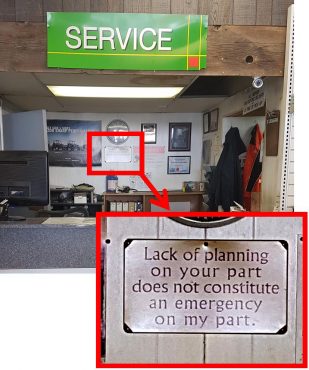
John Bleasby
Are you suffering from Self-Inflicted Service Injuries?
Canadian ContractorGood service is about meeting the needs of your customer, not meeting the convenience of your company!
It takes years for a company to develop a good reputation and strong word-of-mouth following. However, given the availability of today’s online communications and customer rating services, poor service policies and procedures can really injure your business. John Bleasby outlines some major pratfalls, some taken from personal experience. The companies profiled may not be home builders and renovators, but the lessons are universal.
“Our online response system works very well for us.”
It was all about a broken washing machine. Here’s what happened.

Providing responsive customer service is not rocket science
The appliance repair service had a set procedure for handling incoming customer requests — inquiries would not be answered by phone, only using an online form. After three email exchanges dealing with the same questions several times, a service appointment was booked. Assurances were made that a phone call in advance would confirm the time of the technician’s arrival. However, no call was received, no one showed up. Instead, two mails were received within minutes of each other. One said the parts required for the repair had not arrived. The other email claimed that the technician had called at our house but no one answered.
More emails. We asked for a phone call to explain the conflicting emails and to book a new appointment. Instead, more emails were exchanged (18 in total) asking and answering the same questions regarding address, model and serial numbers, and the nature of the problem, plus our repeated requests for a human to call. To no avail.
Yes, the technician arrived on the second appointment, but found he didn’t need any parts to fix the problem. Finished in less than five minutes! However, we were billed $200 for a service call (labor only) based on the time anticipated for a repair that wasn’t required.
I was sent a customer satisfaction survey — by email. I gave a poor review. Ultimately, a phone call took place with the owner. He explained that using emails instead of phone calls meant less administrative staff (ie. lower overheads). The email system worked very well, as far as he was concerned.
Did it work for me, the customer? No.
Lesson One: Are you in the service business? Remember your prime objective — providing service.
Lesson Two: At some point, customers need to talk to human beings!
Lesson Three: Customers aren’t impressed about how efficiently you run your business. They care about the level of service you provide.

Is this the attitude you wish to portray to your customers looking for service?
“Lack of planning on your part does not constitute an emergency on my part”
That’s what the sign says posted behind the service desk, in full view of customers. Funny, right? Not really. It’s actually an insult.
Here’s the story. I had bought a lawn tractor from a dealer in the next town last May because of the excellent reputation of the brand they represented.
The manufacturer’s warranty requires a service and oil change after the first eight hours of run time. I called several times in mid-summer. No one returned my calls. Frustrated, I drove 25 miles to the dealership to speak to service department first hand. “Sorry, we’re really busy right now and won’t be able to pick up your machine for a few weeks,” the service manager said. “But don’t worry about the eight-hour service thing.” That’s when I noticed the sign behind him on the wall (see photo).
I called again a few weeks later and left more messages. Eventually I heard back. “We’re still kind of backed up. Leave it until the fall and have our end-of-season cleanup servicing package included at the same time. We’ll put you on the list.”
No calls. In October, I was mailed a customer satisfaction survey from the manufacturer. I gave the dealership poor marks for service and overall satisfaction. A month later, the son of the dealership owner called. “You didn’t give us a very good rating,” he said. “I’d like to know what the problem was.” I explained. He promised speak to the service manager and indicated I would hear back. I never did. My lawn mower still sits in the garage. Am I happy? No.
Lesson One: Answer the phone, or at least return calls.
Lesson Two: If you commit to performing service, do it.
Lesson Three: If your service department is overloaded with work, hire more staff.
Lesson Four: Get rid of signs that insult customers to their face.

Ercolani (l) attacks a Global News camera crew — not a good strategy for mitigating customer issues.
Sorry seems to be the hardest word
Another thing; in neither case were these words spoken, “I’m sorry you are unhappy with our level of service”. At no point did anyone say, “We’d like to make things better for you and resolve this issue.” The conversations were all about them — systems or attitudes intent on maximizing internal efficiency and lowering costs.
Bad Strategy! Never attack the TV camera crew!
Then there is the case of Maurizio Ercolani. He’s the owner of A.C. Milan Tile of Mississauga, ON, and recently convicted and sentenced for failing to issue refunds after a renovation contract was cancelled by the customer under terms allowed under Ontario’s Consumer Protection Act. Ercolani pled guilty, received a suspended sentence, and was ordered to pay a $2,000 fine plus $7,000 in restitution to the customer.
The court matters were settled in late January of this year. However, back in 2015, and after hearing several other complaints about Ercolani’s failure to refund deposits, Global News sent a camera crew to one of his sites to confront him. Erolani’s reaction? “He attacked a cameraman on video then called 911 claiming he was having a medical emergency,” reports Global News. “After police and fire crews showed up, Ercolani got back in his car and sped off, disobeying a stop sign in view of a police officer. He was ticketed and found guilty under the Highway Traffic Act when he did not show up at trial.”
CLICK HERE to watch the video attack
Providing good service is not rocket science
What is the appropriate way for contractors to react to poor reviews, complaints, or media coverage? Step one might be to not go on the attack. Step two might be to contact the unhappy customer and attempt to resolve the situation, starting with an apology. Then, if the situation is resolved, go online or contact the media and report on the successful outcome of the mediation.
Does your customer response system resemble any of these examples? Hopefully not! Self-inflicted service injuries occur when one fails to take a step back and consider matters from the customers’ perspective. That failure, in turn, can only result in a damaged reputation that can really hurt business going forward.
Please send us your comments, experiences or recommendations.
Confidentiality is assured if requested.
Got feedback? Make your opinion count by using the comment section below,
or by sending an email to:
JBleasby@canadiancontractor.ca
Follow John on Instagram and on Twitter for notifications about his latest posts


Leave a Reply